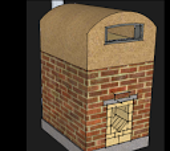




















 1
1




 5
5




My plan is to use a repurposed electric oven with a RS I will cast using refractory materials.




 2
2

































Hans Albert Quistorff, LMT projects on permies Hans Massage Qberry Farm magnet therapy gmail hquistorff




Fox James wrote: I don’t know if you have a tight budget or time constraints but if I were to build a rocket fired pizza oven, I would be taking a different approach.
Fox James wrote: To get really fast heat up times I think you might have to avoid mass in the fire box and heat riser, perhaps look at ceramic fibre board and a ceramic fibre heat riser.
Druce Batstone wrote: I purchased dense and insulating castable (Brisbane Australia). Yes I would cast the complete J stove in insulating castable to make it easier to move and to reduce cost.
Hans Quistorffif I understand correctly you want the air/radiant heat to cook the top of the pizza before the conductive heat burns the bottom. So will you spend the time to build up radiant heat in the walls of the oven or depend on continuous flow of hot gass from the riser to cook the top of the pizza or combine the two by having enough mass well insulated in the oven that can build to radiant heat quickly? [/quote wrote:
Yeah like I mentioned above, I don’t think it’s any good relying on just heat flow.
I have seen Honey Do videos but I don’t understand what is this aircreat? Is it something he came up with? Issue is, we get a very limited range of products here. I can’t even find fire clay.
I almost bought a bag of refractory cement on Monday but lucky you guys say it’s better to build the RS from insulated materials completely, so I am happy.








Fox James wrote: Check out his vids..... https://m.youtube.com/watch?v=5afOmOaFyKM
















Druce Batstone wrote:Have a look at a Perth based supplier www.woodfiredpizzaoven.com.au/refractory-materials/refractory-cements/insulating-render




Fox James wrote: It would seem to make sense to use a insulating product for certain areas at least.








Druce Batstone I would try to incorporate Peter Berg's trip wire and back corner curve in the dense castable .[/quote wrote:
Check out the PPotty's latest video Fox mentioned for an another way of creating turbulence (vortex)
https://www.youtube.com/watch?v=kaBMBrDWsMM&t=849s (around the 2:40 mark)
So simple!
























Graham Chiu wrote: and have a workable pizza oven.




Ethan Pitt wrote:
Any chance for some pictures please?















Graham Chiu wrote: does get the dome to 500 deg C but not the floor. So, potentially his toppings will burn before the crust is cooked..





|
Holly was looking awful sad. I gave her this tiny ad to cheer her up!
The new purple deck of permaculture playing cards
https://www.kickstarter.com/projects/paulwheaton/garden-cards
|








